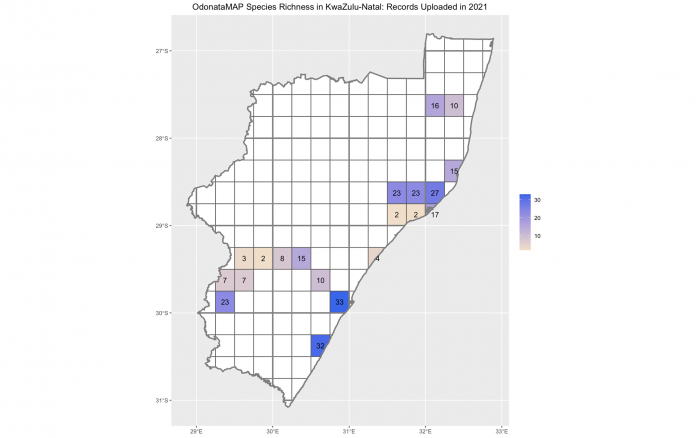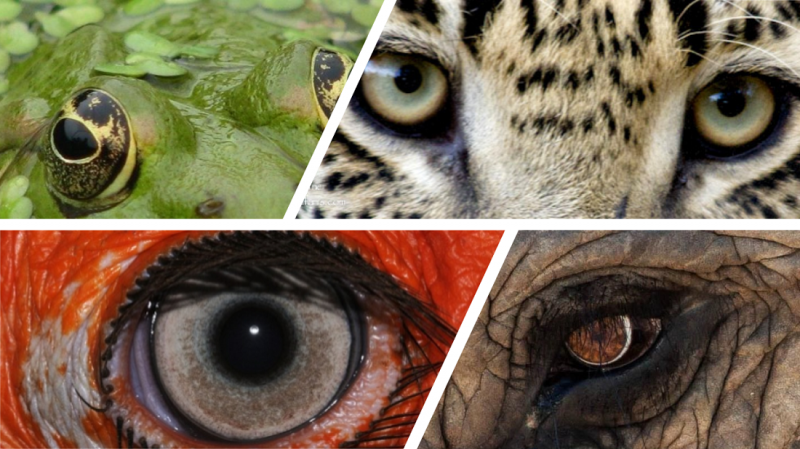The first month of the new year is already behind us! For January 2021 BioMAPpers managed to snap and map almost 10,000 records on biodiversity. Amazingly well done!
Starting from scratch…
OdonataMAPpers in KwaZulu-Natal have started 2021 from scratch. They have taken on board the New Year’s resolution for Team Virtual Museum! “Starting in my home grid cell on 1 January 2021, I will upload records to the Virtual Museum of as many species as possible (and I will be especially careful not to neglect the common species). Wherever I travel in 2021, I will do my best to keep the distribution maps up-to-date for as many species as possible.”

This is what Team KZN has achieved halfway through the first month of 2021 for OdonataMAP. By taking this approach we are keeping the records fresh, and this is especially important for the common species, which we tend to neglect.
This map is based on records uploaded in 2021 by 17 January and identified by the expert panel. The numbers in the grid cells represent species richness by this date
BDI Citizen Scientist Hours
BDI Citizen Scientist Hour #20 was held on Thursday 28 January 2021. We had two great talks lined up for the evening. These were:
- Karis Daniel: “It takes a village: Why biodiversity needs citizen scientists and their data”
Karis, a recent PhD candidate at UCT, shared the reasoning behind her current research, exploring how Citizen Science as a discipline not only contributes to scientific research, but also plays a key role in creating long-term conservationist attitudes and lifestyles in broader communities.
- David Thomson: “Upper thermal limits, and the ecological impact of rising temperatures in hot regions“
Climate is changing throughout the World, but there are marked regional differences in the pace of this change, in the impacts, the intensity of research, and the amount of biodiversity at risk. David talked about the information they have synthesized from hundreds of studies worldwide to determine the upper thermal limits of ectotherms, and the extent to which they could be endangered by rising temperatures in hot versus cool regions.
On Wednesday 20th January 2021, the BDI Citizen Scientist Hour had another two awesome talks for the evening.
- Melissa Whitecross: “BirdLife South Africa’s Secretarybird project“
Melissa, who is BirdLife SA’s Landscape Conservation Programme Manager, shared insights about South Africa’s Secretarybirds and how citizen science is assisting with monitoring these Endangered sentinels of the grasslands and open landscapes.
- Les Underhill: “The Virtual Museum: achievements of 2020 and plans for 2021”
Les reviewed the record-breaking year which the Virtual Museum achieved in 2020 and he set some targets for 2021. The main goal for the year is to keep the distribution maps up-to-date by continually refreshing records of species in grid cells. He will introduced us to new ways of measuring up-to-dateness.
You can catch up on all the various talks on our YouTube Channel!
The Fundamentals of Citizen Science – A BDI Course
We believe that citizen scientists can make a significant contribution towards healing the massive biodiversity issues of our generation. On one hand, citizen scientists enable up-to-date distribution maps for species to be made. On the other hand, citizen scientists generate civic awareness for biodiversity in their communities, becoming “ambassadors for biodiversity.” You can be a part of this by attending the BDI’s week-long Fundamentals of Citizen Science course.
We plan to run the course multiple times in 2021, at different venues. Provisionally (but with accommodation booked at the three places), these dates have been selected: 21–28 February at Karoo Gariep Nature Reserve, Hanover; 11–18 April at Karoo Plains, Carnarvon; 6–13 August at Botuin, Vanrhynsdorp.
How do you apply? Start by sending an email to Megan at megan@thebdi.org


